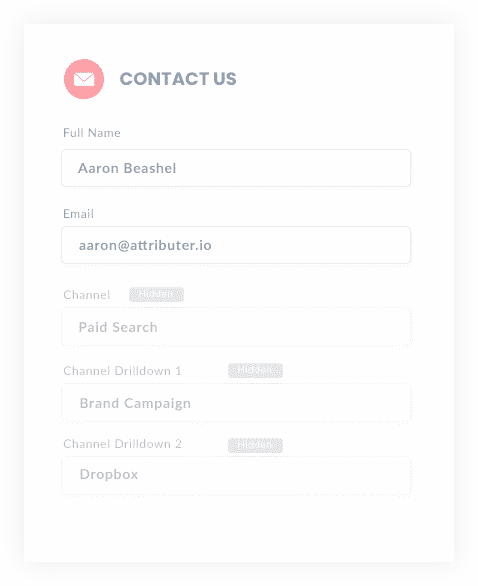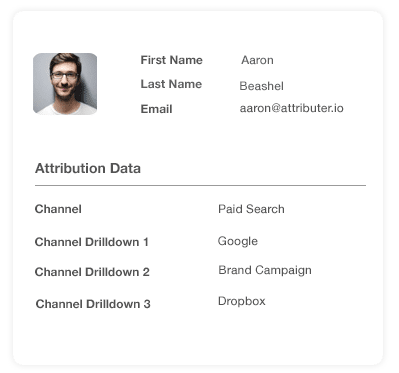The easiest way to get UTM Parameters into Insightly
Track UTM parameters in Insightly and know what marketing campaigns are effectively bringing in leads and customers

When it comes to growing a business, marketers need to know exactly what marketing channels, content, and campaigns are working.
This means finding out what is generating leads and customers. Simply put, what channels are leading to positive ROIs.
Having this data allows you to then put more time and resources into your most successful marketing channels.
You may have no way of currently knowing where your leads are coming from or which marketing channels are working. And, if that's the case, then you're wasting a lot of valuable time and resources. You're also unconsciously ignoring the opportunity to maximize your revenue.
Warren Buffett was once quoted to have said that "Opportunities come infrequently. When it's raining gold, reach for a bucket, not a thimble."
In our work, we have found that the best way to measure success in marketing is by tracking the source of every single lead and opportunity in your CRM. By having this data, you can run valuable reports, instantly know where your leads and sales originated from and doubling down on those marketing efforts.
Here, you'll learn how to capture UTM parameters in Insightly and send tracking data for your leads to your CRM or other software tools for reporting and analysis.
4 steps for capturing UTM parameters in Insightly
Using Attributer to capture UTM parameters in Insightly is easy. Here's how to do it in 4 easy steps:
1. Add UTM variables to your ads

If you want to track where your hottest leads are coming from in your CRM, it is imperative for you to add UTM parameters to every single one of your ads and marketing campaigns. These UTM parameters allow Attributer to capture tracking data and send it to your CRM via your Insightly.
Don't forget to include UTM parameters to ALL inbound links to your website. This means social media bios, social media posts, paid ads (Bing, Google, Facebook, Instagram, etc.), spotlight blogs, marketable influencer campaigns, and any and every other marketing channel.
2. Add hidden fields to your forms

Secondly, add hidden fields to your website forms so that Attributer can add UTM parameters to any form users might complete.
It may come as no surprise that hidden fields are invisible to the user, but the value comes from the fact that Attributer can identify and complete these fields with UTM parameters that have been captured behind the scenes.
Attributer will need the following six hidden fields:
- Channel
- Channel Drilldown 1
- Channel Drilldown 2
- Channel Drilldown 3
- Landing Page
- Landing Page Group
Adding these fields to your forms is usually pretty easy. Form builders like Gravity Forms, Typeform, Jotform, etc all have simple point-and-click ways to add hidden fields and full instructions can be seen here.
3. Attributer automatically completes the hidden fields with UTM data

With everything set up, Attributer will start to capture incoming tracking data, including all UTM parameters, and it will add these to the hidden fields in your forms.
Let's take a quick look at how Attributer works. Let's look at a Dropbox ad for a demo request as an example.
A user Googles "ways to share large files" and finds a Dropbox ad in the paid results. The user clicks the ad and fills out a form to request a demo. In the form's hidden fields, Attributer will add the following tracking information from the UTM parameters:
- Channel = Paid Search
- Channel Drilldown 1 = Google
- Channel Drilldown 2 = Brand Campaign
- Channel Drilldown 3 = Dropbox
Not only that, Attributer will also include the landing page information, which might look something like this:
- Landing Page = www.dropbox.com/features/share
- Landing Page Group = Features
4. UTM parameters are passed into Insightly

Lastly, and most importantly, when a visitor submits any form with the hidden fields completed by Attributer, the UTM parameters will captured and sent to Insightly.
You can then use the reporting tools in Insightly to understand what channels and campaigns are driving your leads, customers & revenue.
Alternatively, you can connect various analytics tools to Insightly and run more details reports there.
What is Attributer?
Attributer lets you capture UTM parameters and other tracking data about your leads and send it to Insightly.
So how does Attributer work? Check out this quick overview.
When the Attributer code is placed on a website, the tool will monitor for new visitors to your site and look at technical data about the visitor, such as the user's device, HTTP referrer information, UTM parameters, etc.
After categorizing each visitor into one of the several channels (Paid Search, Organic Search, and Paid Social are good examples), Attributer then stores that data as a cookie in the user's browser.
As long as you have set up the hidden fields correctly in your forms, Attributer will include the UTM parameters alongside any other details the user submits (name, email, mobile, etc.) when the user completes any form on your website.
Attributer was created a B2B marketing consultant who saw the need for a tool to identify which channels were producing leads and customers.
"I originally built it to use on my client's website but after a while, I realized it could be useful for businesses everywhere."
Why using Attributer is better than capturing raw UTM parameters
There are several tools that capture UTM parameters in Insightly, so why use Attributer over anything else?
1. Captures all traffic
What makes Attributer unique is that it monitors and captures data for every user that lands at your website. Other tools only work when UTM parameters are present, but Attributer will return attribution data on all users to your site, including those that come through organic channels such as Organic Social, Organic Search, Direct, Referral, etc.
With Attributer, every lead in your CRM will have accurate and precise tracking data, not just those that came from your paid ad campaigns.
2. Remembers the data
Most other tools that capture UTM parameters require the UTM parameter to actually be present on the page where the form is completed. This is a problem because the page they complete your contact form on on may not be the same page they landed on from your ad.
As an example, imagine someone clicks one of your Google Ads and goes to your homepage. Once they’re convinced your product or service is amazing, they click the ‘Contact Us’ button and are taken to the Contact page on your website where they fill out your contact form. This would mean that the page they completed your form on is not the same page they originally landed on, so the UTM parameters are lost.
Attributer works differently. It stores the UTM parameters in a cookie in the user’s browser, meaning that when a visitor completes the form on your Contact Us page Attributer still knows the original UTM parameters that visitor arrived with.
3. Provides cleaner data
Attributer is also the only tool that cleans and categorizes your data for you. If you regularly use UTM parameters, you probably already know that raw UTM data is very messy and inconsistent.
Let's look at an example: Let's pretend some of your LinkedIn campaigns are tagged with UTM_Source=LinkedIn.com (capital L), others with UTM_Source=linkedin (lowercase, no domain), and others with UTM_Source=li.
Running a report on this data would show three different sources (LinkedIn.com, Linkedin, li) instead of just one.
Attributer is different however. It was designed to recognize capitalization and other inconsistencies and categorise all these leads as Paid Social regardless of these differences.
4. Captures landing page data as well
Another valuable feature of Attributer is that the tool captures landing page data and UTM parameters. Using this data, you can analyze your best-performing content and subdirectories, like a blog.
For example, imagine a user lands on attributer.io/blog/capture-utm-parameters. Attributer will capture the landing page URL (attributer.io/blog/capture-utm-parameters) and the subdirectory (/blog) in two separate fields.
Now you can see which content and which categories or subdirectories convert the most website visitors. You can use this data to determine whether your blog content or paid ads deliver the best ROI and reallocate resources accordingly.
Wrap up
Attributer does more than just capture UTM parameters and send them into Insightly. It's a multi-faceted tool that delivers accurate tracking data about every single one of your users.
Want to see how Attributer can help improve your sales & marketing efforts? Sign up for a 14-day free trial today.
Get Started For Free
Start your 14-day free trial of Attributer today!

About the Author
Aaron Beashel is the founder of Attributer and has over 15 years of experience in marketing & analytics. He is a recognized expert in the subject and has written articles for leading websites such as Hubspot, Zapier, Search Engine Journal, Buffer, Unbounce & more. Learn more about Aaron here.
